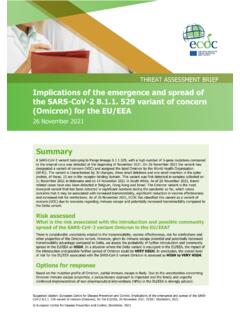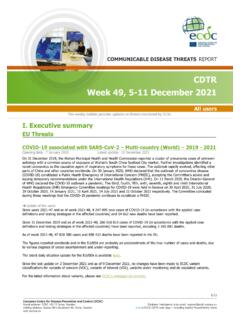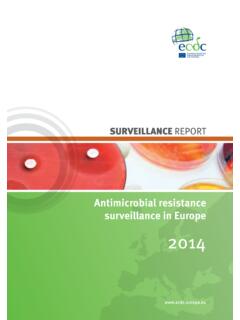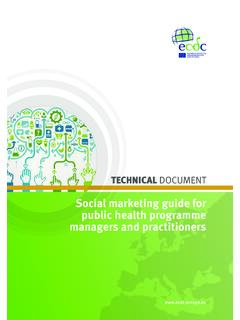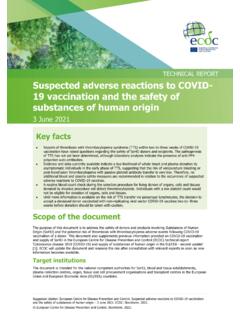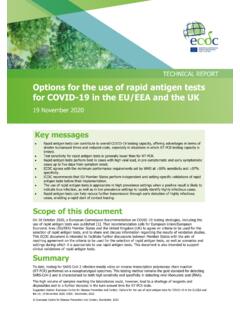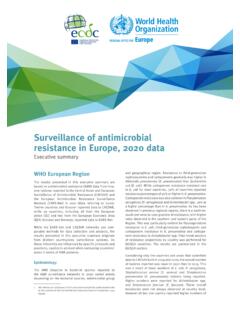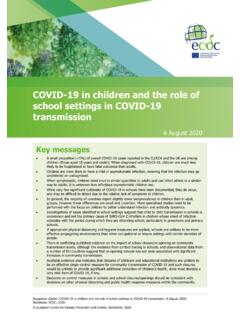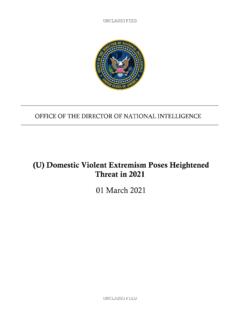Transcription of Threat assessment brief - Emergence of SARS-CoV-2 variant ...
1 Suggested citation: European Centre for Disease Prevention and Control. Implications of the spread of the SARS-CoV-2 variant of concern (Omicron) for the EU/EEA first update. 2 December 2021. ECDC: Stockholm; 2021. European Centre for Disease Prevention and Control, Stockholm, 2021 Threat assessment brief Implications of the further Emergence and spread of the SARS-CoV-2 variant of concern (Omicron) for the EU/EEA first update 2 December 2021 Summary The number of countries reporting SARS-CoV-2 Omicron variant of concern (VOC) cases continues to increase globally, with a total of 352 confirmed cases reported by 27 countries as of on 1 December 2021, including 70 confirmed cases reported by 13 European Union and European Economic Area (EU/EEA) countries. The majority of confirmed cases have a history of travel to southern African countries, with some having taken connecting flights at other destinations between Africa and Europe. Several European countries have already reported subsequent community or household transmission.
2 All cases for which there is available information on severity were either asymptomatic or mild. To date, there have been no severe cases and no deaths reported among these cases. Current evidence on transmissibility, severity, and immune escape is highly uncertain for the Omicron VOC. However, preliminary data from South Africa suggest that it may have a substantial growth advantage over the Delta VOC. If this is the case, mathematical modelling indicates that the Omicron VOC is expected to cause over half of all SARS-CoV-2 infections in the EU/EEA within the next few months. The greater Omicron's growth advantage over the Delta VOC and the greater its circulation in the EU/EEA, the shorter the expected time until the Omicron VOC causes the majority of all SARS-CoV-2 infections. The presence of multiple mutations in the spike protein of the Omicron VOC indicates a high likelihood of reduction of neutralising activity by antibodies induced by infection or vaccination.
3 Preliminary data suggest that the Omicron VOC may be associated with increased risk of reinfection in South Africa. However, the full extent to which the Omicron VOC evades or erodes existing vaccine- or infection-derived immunity remains uncertain in the absence of in vitro neutralisation data, vaccine effectiveness data, and further data on reinfection in populations exposed to different SARS-CoV-2 variants during previous pandemic waves. Risk assessed What is the risk associated with the further introduction and spread of the SARS-CoV-2 variant Omicron in the EU/EEA? The evidence from the initial cases of this new variant that has been collated from around the world is limited, but suggests that the Omicron VOC may be associated with higher transmissibility than the Delta VOC, although robust evidence is still lacking. There remains considerable uncertainty related to vaccine effectiveness, risk for Threat assessment brief Implications for the EU/EEA on the spread of the SARS-CoV-2 variant first update 2 Event background On 26 November 2021, ECDC classified a SARS-CoV-2 variant belonging to Pango lineage as a variant of concern (VOC) due to concerns regarding immune escape and potentially increased transmissibility compared to the Delta variant .
4 WHO also classified the variant as a VOC and assigned it the label Omicron. The novel SARS-CoV-2 variant Omicron was first detected in samples collected on 11 November 2021 in Botswana, and subsequently in samples collected from 14 November and onward in South Africa. The number of countries reporting the Omicron VOC cases continues to increase globally, with a total of 352 confirmed cases reported by 27 countries as of 16:00 on 1 December 2021. To date, there have been no severe cases or deaths reported globally. As of 16:00 on 1 December 2021, 70 confirmed Omicron variant cases have been reported by EU/EEA countries. The cases have been reported by 13 European Union and European Economic Area (EU/EEA) countries: Austria (3) [1], Belgium (2) [2], Czechia (1) [3], Denmark (4) [4], France (1 in R union) [5], Germany (10) [6], Ireland (1) [7], Italy (9) [8], the Netherlands (16) [9], Norway (4) [10], Portugal (14) [11], Spain (2) [12], and Sweden (3) [13] according to information from public sources.
5 A number of probable cases have also been reported from reinfections, and other properties of the Omicron VOC. Based on these factors, the probability of further introduction and community spread of the Omicron VOC in EU/EEA countries is currently assessed as HIGH. Current estimates on the severity of the infection associated with the Omicron VOC remain highly uncertain. The currently available evidence raises serious concern that the Omicron VOC may be associated with a significant reduction in vaccine effectiveness and increased risk for reinfections. The degree of protection against severe disease with the Omicron VOC conferred by past COVID-19 infection or by vaccination is not yet known. EU/EEA countries are still facing the severe impact of high numbers of cases of the Delta VOC. The impact of the further introduction and spread of the Omicron VOC could be VERY HIGH, but this situation needs to be evaluated as further information emerges. Based on the currently available limited evidence, and considering the high level of uncertainty, the overall level of risk for EU/EEA countries associated with the further Emergence and spread of the SARS-CoV-2 Omicron VOC is assessed as HIGH TO VERY HIGH.
6 Options for response To date, the Omicron VOC has already been introduced into many EU/EEA countries. Given the current limited evidence around this new variant and the concerns about its immune escape properties in relation to available COVID-19 vaccines and treatments, a multi-layered approach to delay the spread of this VOC in the EU/EEA is needed. Due to the ongoing circulation of the Delta VOC, EU/EEA countries are urged to give utmost priority towards the vaccination of people initially targeted by COVID-19 vaccination programmes who remain unvaccinated or who are not yet fully vaccinated. Countries should consider a booster dose for people aged 40 years and older, first targeting the most vulnerable and the elderly, and could then consider a booster dose for all adults aged 18 years and older at least six months after completion of the primary series. Non-pharmaceutical interventions (NPIs) that have proven to be very effective in reducing transmission of infection should continue to be implemented by countries based on an assessment of their epidemiological situation regarding the Delta VOC, and taking into account the uncertainty of the situation regarding the Omicron VOC.
7 Physical distancing measures, ensuring adequate ventilation in closed spaces, the maintenance of hand and respiratory hygiene measures, the appropriate use of face masks, and staying home when ill all remain relevant. Enhanced contact tracing measures such as backward contact tracing and stricter management of contacts could help slow the establishment of the Omicron VOC in the country. Genomic surveillance remains of the utmost importance for early detection of the presence of the variant , to enable the following of epidemiological trends and guide containment measures. Temporary travel-related measures should be carefully considered in light of the latest epidemiological situation, and should be regularly reviewed as new evidence emerges. Such measures might include the testing and quarantining of travellers who have recently returned from affected countries and sequencing cases identified among travellers. Public information around the emerging situation and the public health measures in place for returning travellers from affected areas are important to raise awareness and support the effective implementation of these measures.
8 However, given the increasing number of cases and clusters in the EU/EEA without a travel history or contact with travel-related cases, it is likely that within the coming weeks the effectiveness of travel-related measures will significantly decrease, and countries should prepare for a rapid and measured de-escalation of such measures. Threat assessment brief Implications for the EU/EEA on the spread of the SARS-CoV-2 variant first update 3 across the region, but these are under investigation. The majority of confirmed cases have a history of travel to southern African countries, with some having taken connecting flights at other destinations between Africa and Europe. Several countries reported community or household transmission (Germany [14], Italy [15], Portugal [16], Israel [17], and the United Kingdom [18,19]). All cases for which there is available information on severity were either asymptomatic or mild. No severe cases and no deaths have been reported among these cases to date.
9 Outside of the EU/EEA, 282 confirmed cases have been reported in 14 countries and territories outside of the EU/EEA (Australia [20], Botswana [21], Brazil [22], Canada [23,24], Ghana [25], Hong Kong Special Administrative Region [21], Israel [17], Japan [26], Nigeria [27], Saudi Arabia [28], South Africa [21], South Korea [29], Switzerland [30], and the United Kingdom) [31] (as of data available at 16:00 on 1 December 2021). Figure 1. Confirmed COVID-19 Omicron cases detected in the EU/EEA, by date of reporting, as of 1 December 2021 Sequence reporting from the African region The reporting of sequencing results in the African region is low overall. Only Botswana, South Africa, Ghana, and the French overseas department R union have reported sequences from samples collected within the last 30 days to a level that allows for detection of community transmission of Omicron. This means that ongoing transmission of this variant cannot be excluded for other countries. Since the variant is spread across regions within South Africa and has also been detected in significant numbers in Botswana and Ghana, circulation in other countries is likely.
10 Table 1. Number of the Omicron VOC sequences reported to GISAID EpiCoV from samples collected since 1 November 2021 from all countries and territories in the African region, as defined by GISAID Country or territory Number of Omicron sequences Total sequences reported Botswana 19 99 Ghana 33 53 Kenya 0 3 Mayotte 0 15 Nigeria 0 1 Democratic Republic of the Congo 0 8 France (La R union) 1 86 Senegal 0 4 South Africa 172 249 Data extracted from GISAID EpiCoV on 1 December 2021 at 15:30 CET. Threat assessment brief Implications for the EU/EEA on the spread of the SARS-CoV-2 variant first update 4 The Omicron variant of concern properties The VOC (Omicron) belongs to Pango lineage , Nextstrain clade 21K, and is characterised by 30 amino acid changes, three small deletions and one small insertion in the spike protein compared to the original virus (A67V, 69-70, T95I, G142D, 143-145, 211, L212I, ins214 EPE, G339D, S371L, S373P, S375F, K417N, N440K, G446S, S477N, T478K, E484A, Q493R, G496S, Q498R, N501Y, Y505H, T547K, D614G, H655Y, N679K, P681H, N764K, D796Y, N856K, Q954H, N969K, L981F).
